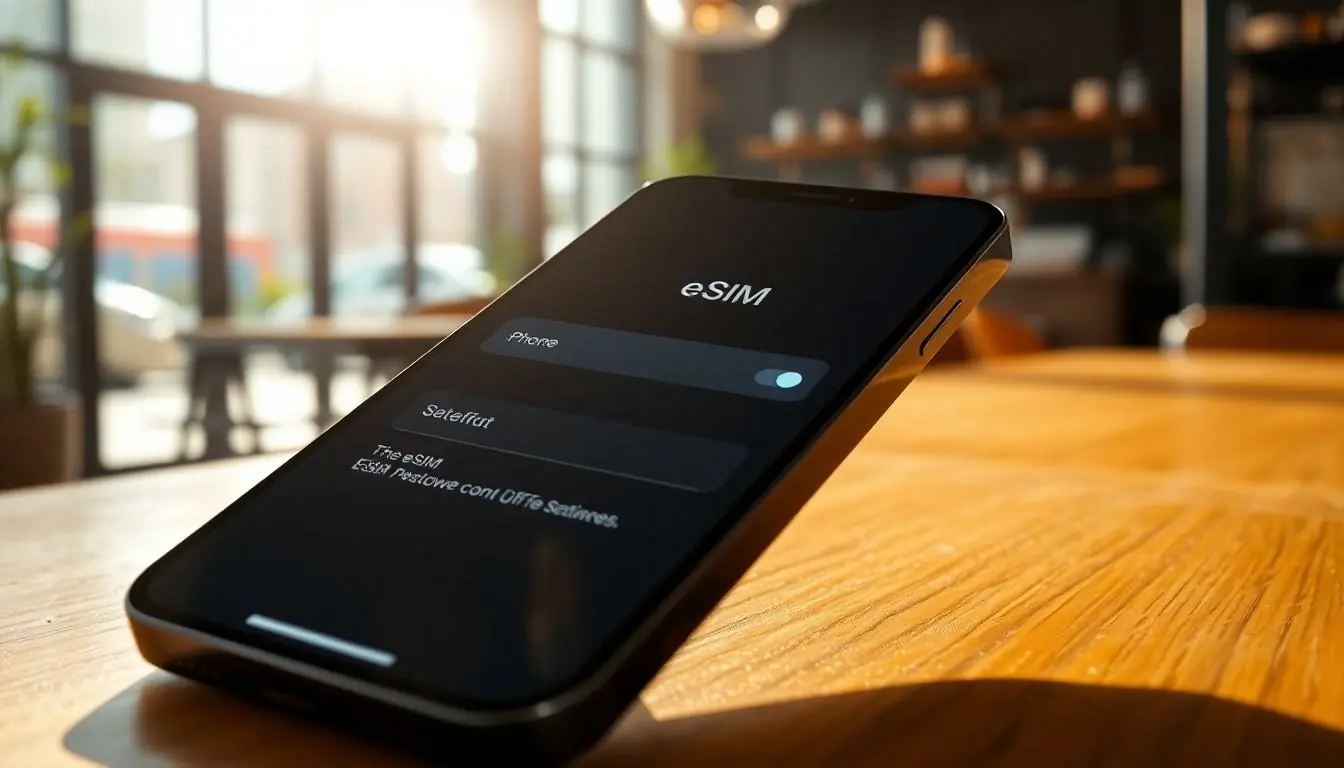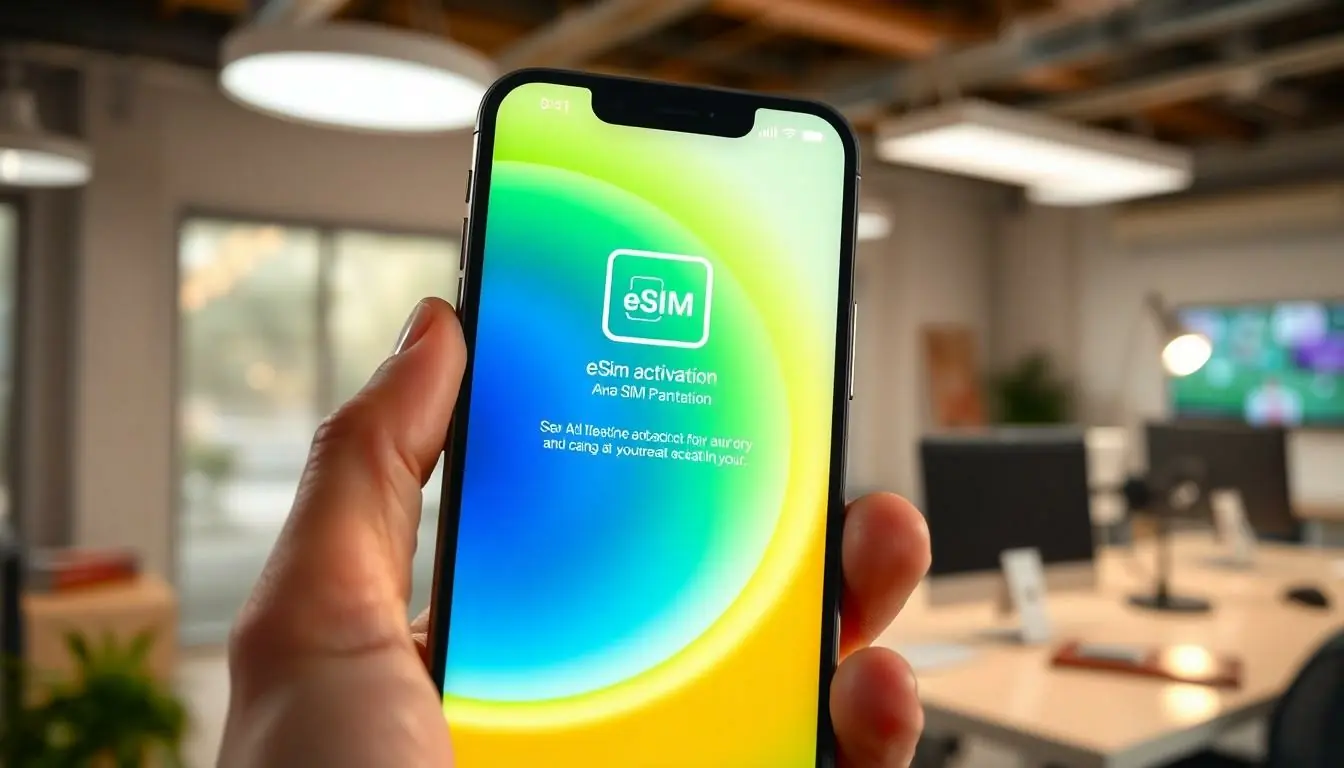Table of Contents
ToggleIn a world where juggling multiple devices feels like a circus act, the iPhone 12 steps in with a magic trick of its own: eSIM technology. Gone are the days of fumbling with tiny SIM cards while trying to unlock the secrets of your phone. With eSIM, users can switch carriers or add plans with just a few taps, making life a whole lot easier—and a little less chaotic.
But can the iPhone 12 really pull off this digital sleight of hand? Absolutely! Not only does it support eSIM, but it also allows for dual SIM functionality. So, whether you’re traveling abroad or simply want to keep work and personal lines separate, the iPhone 12 has got you covered. Let’s dive into the details and discover how this feature can transform your mobile experience.
Overview of eSIM Technology
eSIM technology revolutionizes how users manage mobile plans by removing the need for physical SIM cards. It allows for seamless carrier switching and plan addition, enhancing mobility and convenience.
What Is eSIM?
eSIM stands for embedded SIM. Unlike traditional SIM cards, it is built directly into a device, such as the iPhone 12. Users can activate cellular plans without inserting a physical card. This integration streamlines the mobile experience, allowing for quick and easy management of multiple lines directly through the device settings. Additionally, carriers support eSIM technology, making it widely accessible.
Benefits of eSIM
eSIM technology offers several advantages. It enhances convenience by allowing users to switch plans without visiting a store. Furthermore, eSIM enables dual SIM functionality, useful for balancing work and personal lines. Users traveling abroad appreciate the ability to adopt local carriers without physical SIM swaps. Potential for device compatibility extends to various models, making eSIM a future-proof choice in mobile technology. Enhanced security features also protect user data, reducing the risk of card theft or loss.
Compatibility of iPhone 12
The iPhone 12 features advanced eSIM technology. This functionality enhances flexibility for users needing dual SIM capabilities.
eSIM Support in iPhone Models
Apple introduced eSIM support starting with the iPhone XS, XS Max, and XR. The iPhone 12 offers this feature alongside its predecessors. Numerous carriers worldwide support eSIM activation for the iPhone 12, providing options for users. eSIMs simplify the experience by eliminating the need for physical cards. This integration allows users to manage multiple plans effectively.
How to Check Compatibility
Checking compatibility involves a few simple steps. Users should start by contacting their mobile carrier to confirm eSIM support. Apple’s official website also provides a list of supported carriers. Settings on the device offer another way to obtain compatibility details. By navigating to Settings, tapping Cellular, and selecting Add Cellular Plan, users can evaluate their options. It’s crucial to ensure the chosen plan includes eSIM functionality for seamless operation.
Setting Up eSIM on iPhone 12
Setting up eSIM on an iPhone 12 is straightforward. Users can activate their eSIM by following a few simple steps.
Steps for Activation
- Access Settings from the home screen.
- Select Cellular or Mobile Data.
- Tap Add Cellular Plan.
- Scan the QR code provided by the carrier or enter details manually.
- Follow the on-screen instructions to complete the setup.
Completing these steps activates the eSIM, integrating it seamlessly with existing mobile plans.
Troubleshooting Common Issues
Many users encounter problems during eSIM activation. Checking the QR code for accuracy is essential. Incorrect information may prevent successful connection.
Verifying that the carrier supports eSIM can resolve compatibility issues. Restarting the device often helps in resetting the connection. Restoring cellular settings also resolves persistent problems. If issues continue, contacting the carrier or Apple support provides additional assistance.
iPhone 12 vs. Traditional SIM
The iPhone 12 offers a modern alternative to traditional SIM cards with its eSIM technology. Users experience streamlined convenience when managing their mobile plans.
Advantages of Using eSIM
Enhanced flexibility defines the eSIM experience. Switching between different carriers doesn’t require a physical SIM card. Users can quickly switch plans or add new lines without visiting a store. Multiple carrier options are available across various regions, providing access to local telecom services when traveling. This feature is especially beneficial for frequent travelers who want to avoid high roaming costs. Additionally, eSIM contributes to better security by reducing the risks associated with losing a physical SIM card.
Disadvantages of Using eSIM
Despite the advantages, some challenges accompany using eSIM technology. Not all carriers support eSIM activation, potentially limiting options for certain users. Activating an eSIM might also involve a more complicated initial setup compared to simply inserting a SIM card. Troubleshooting issues can arise, particularly during the activation process, requiring additional technical support. Lastly, some users may still prefer the tangible nature of a physical SIM card for ease of use and familiarity.
Conclusion
The iPhone 12’s eSIM technology marks a significant advancement in mobile connectivity. Users can enjoy the freedom to manage multiple plans without the hassle of physical SIM cards. This feature not only simplifies switching carriers but also enhances the overall mobile experience, especially for those who travel frequently.
While eSIM offers numerous benefits, it’s essential to consider the limitations and initial setup challenges. However, with growing carrier support and user-friendly processes, the iPhone 12 stands out as a versatile device for modern mobile needs. Embracing eSIM could very well redefine how users interact with their mobile plans, making life on the go much easier.





